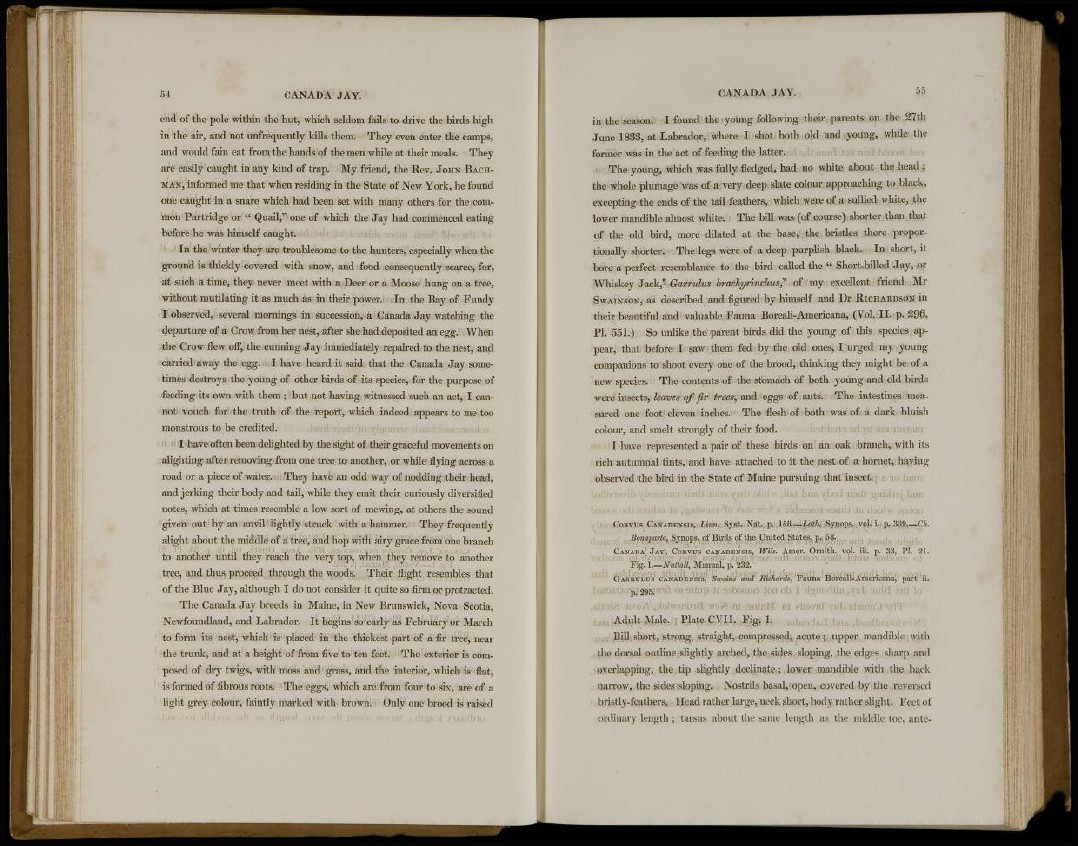
54 CANADA JAY.
end of the pole within the hut, which seldom fails to drive the birds high
in the air, and not unfrequently kills them. They even enter the camps,
and would fain eat from the hands of the men while at their meals. They
are easily caught in any kind of trap. My friend, the Rev. JOHN BACHMAN,
informed me that when residing in the State of New York, he found
one caught in a snare which had been set with many others for the common
Partridge or " Quail," one of which the Jay had commenced eating
before he was himself caught.
In the winter they are troublesome to the hunters, especially when the
ground is thickly covered with snow, and food consequently scarce, for,
at such a time, they never meet with a Deer or a Moose hung on a tree,
without mutilating it as much as in their power. In the Bay of Fundy
I observed, several mornings in succession, a Canada Jay watching the
departure of a Crow from her nest, after she had deposited an egg. When
the Crow flew off, the cunning Jay immediately repaired to the nest, and
carried away the egg. I have heard it said that the Canada Jay sometimes
destroys the young of other birds of its species, for the purpose of
feeding its own with them ; but not having witnessed such an act, I cannot
vouch for the truth of the report, which indeed appears to me too
monstrous to be credited.
I have often been delighted by the sight of their graceful movements on
alighting after removing from one tree to another, or while flying across a
road or a piece of water. They have an odd way of nodding their head,
and jerking their body and tail, while they emit their curiously diversified
notes, which at times resemble a low sort of mewing, at others the sound
given out by an anvil lightly struck with a hammer. They frequently
alight about the middle of a tree, and hop with airy grace from one branch
to another until they reach the very top, when they remove to another
tree, and thus proceed through the woods. Their flight resembles that
of the Blue Jay, although I do not consider it quite so firm or protracted.
The Canada Jay breeds in Maine, in New Brunswick, Nova Scotia,
Newfoundland, and Labrador. It begins so early as February or March
to form its nest, which is placed in the thickest part of a fir tree, near
the trunk, and at a height of from five to ten feet. The exterior is composed
of dry twigs, with moss and grass, and the interior, which is flat,
is formed of fibrous roots. The eggs, which arc from four to six, are of a
light grey colour, faintly marked with brown. Only one brood is raised
CANADA JAY.
in the season. I found the young following their parents on the 27th
June 1833, at Labrador, where I shot both old and young, while the
former was in the act of feeding the latter.
The young, which was fully fledged, had no white about the head ;
the whole plumage was of a very deep slate colour approaching to black,
excepting the ends of the tail feathers, which were of a sullied white, the
lower mandible almost white. The bill was (of course) shorter than that
of the old bird, more dilated at the base, the bristles there proportionally
shorter. The legs were of a deep purplish black. In short, it
bore a perfect resemblance to the bird called the " Short-billed Jay, or
Whiskey Jack," Garrulus bracliyrinchus? of my excellent friend Mr
SWAINSON, as described and figured by himself and Dr RICHARDSON in
their beautiful and valuable Fauna Boreali-Americana, (Vol. I I . p. 296,
PI. 551.) So unlike the parent birds did the young of this species appear,
that before I saw them fed by the old ones, I urged my young
companions to shoot every one of the brood, thinking they might be of a
new species. The contents of the stomach of both young and old birds
were insects, leaves of fir trees, and eggs of ants. The intestines measured
one foot eleven inches. The flesh of both was of a dark bluish
colour, and smelt strongly of their food.
I have represented a pair of these birds on an oak branch, with its
rich autumnal tints, and have attached to it the nest of a hornet, having
observed the bird in the State of Maine pursuing that insect.
CORVUS CANADENSIS, Linn. Syst. Nat. p. 158—Lath. Synops. vol. i. p. ,'JO!) Ch.
Bonaparte, Synops. of Birds of the United States, p. 58.
CANADA] JAY, CORVUS CANADENSIS, Wils. Amer. Ornith. vol. iii. p. 3.'}, PT. 21.
Fig. 1—Nuttall, Manual, p. 232
GARRULUS CANADENSIS, Sivains and Richards, Fauna Boreali-Americana, part ii.
p. 295.
Adult Male. Plate CVII. Fig. 1.
Bill short, strong, straight, compressed, acute; upper mandible with
the dorsal outline slightly arched, the sides sloping, the edges sharp and
overlapping, the tip slightly decimate; lower mandible with the back
narrow, the sides sloping. Nostrils basal, open, covered by the reversed
bristly-feathers. Head rather large, neck short, body rather slight. Feet of
ordinary length ; tarsus about the same length as the middle toe, ante